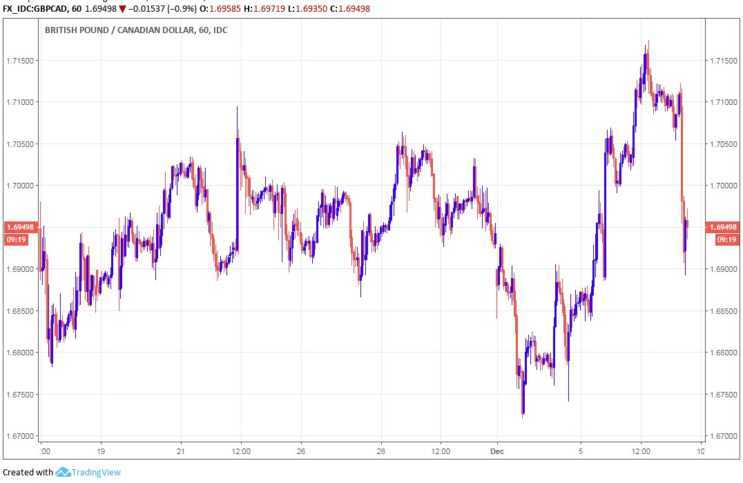- CAD surges after sound November labour market data.
- Despite healthy Jobs and unemployment, wages continue to disappoint.
- Bank of Canada outlook softened due to the positive data report
- A brief relief for CAD after a dark few months
Friday was a happy day for the Canadian Dollar after it strengthened rapidly after November’s labour market report showed the economy creating jobs faster than expected. It grew so much the unemployment rate moved to a record low.

The details of the data released showed Canada’s economy created 94,000 new jobs during November, crucially up from 11,200 previously. The markets had factored in just 10,500. This nudged the unemployment rate down by 20 basis points to a record low of 5.6%. A plethora of economists had predicted a steady at 5.8%.
It wasn’t all a bed of roses on Friday. The annualised pace of wage growth slipped further in November, to 1.5%. Economists had anticipated that it would fall only 10 basis points, from 1.9% to 1.8%. The 0.3% difference was significant enough not to have investors getting carried away.
The details showed French-speaking Quebec and the Alberta provinces leading the jobs gains, with a growth of 26,000 in the former and 24,000 for Alberta.
Concern remains on whether the jobs that have been created in November will and can be sustained. The worry amongst investors is the gain in jobs will keep a January rate hike on the table for now. Validation from other indicators needs to occur before more macro trends and predictions can be made. Markets like and care about the labour market data because generally falling unemployment and improving job creation are thought to put upward pressure on wages. It’s obviously a sign of strong foundations within an economy.
Wage growth leads to increased demand in an economy and puts upward pressure on inflation, with implications for interest rates and financial markets. It should, in theory, increase consumer spending and with Christmas around the corner, this will undoubtedly have a knock-on effect.
Stephen Brown, an economist at Capital Economics commented wisely that “The surge in employment was partly led by Alberta where the outlook has since deteriorated markedly due to the slump in oil prices. Meanwhile, the further drop in wage growth left room for the Bank of Canada to err on the side of caution in the coming months.” Oil prices have grown 300% in 3 months but dropped 30% in 6 months.
CAD has been badly beaten in recent weeks, so a cleanse in positioning is in order. That said, we think gains from here will prove to be limited,” says Mazen Issa, a strategist at Toronto-headquartered TD Securities. “We expect USDCAD support near 1.3250 to be formidable and CADJPY rallies to be faded.
The USD/CAD rate was quoted -0.76% lower at 1.3295 following the release after reversing an earlier 0.02% gain. That follows substantial gains over Wednesday and Thursday, which have left the rate up 5.7% for 2018.
The £-to-Canadian Dollar rate was -0.95% lower at 1.6948 after falling from 1.7105 before the release. After the Friday, the Loonie was quoted higher against all G10 currencies.
The outlook for relative central bank policy has deteriorated materially as market participants have softened their expectations for Bank of Canada tightening in response to Wednesday’s movements. Given concerns about the recent oil price action, language around any major changes has reverted back to the rhetoric of 2015.
The end of this year has seen a complete slump for oil, Canada’s largest export. Especially, during October leading the global benchmark Brent crude to decline by 10% in October alone while Western Canadian Select plummeted to fresh record lows.
The bearish sentiment has caused the oil price to continue to fall in November. In response, the Alberta government cut production from local producers and the BoC to warn this week of an increasing threat to the economy. Any major changes in the oil price over consecutive months will have a profound effect on sentiment as well as a direct impact on other parts of the Canadian economy, which inevitably will start to take hold on the exchange rate.
In response, Canada’s central bank has now cooled its bullish tone that it would look to increase the speed of interest rate rises in 2019. The changes dealt a knock to the CAD this week. Friday’s jobs data could prevent the outlook for the Canadian currency from getting more and more negative over the short-term and early next winter. More pertinent oil news was released this week as OPEC, Organization of Petroleum Exporting Countries (the most influential and controlling oil trading nations) agreed and announced oil production would be cut by 1.2 million barrels per day. The news is better than expected by not revolution. The markets would expect the price of oil to rally back to nearer $70 to settle nerves. The technical see a solid floor around $58.
The Bank of Canada has been relatively active in the final quarter of this year. They raised interest rates by 25 basis points to 1.75% and have insinuated they would continue the gentle rise until 2020 when rates could be nearer 3.5% subject to no major sceneries. However, it held the cash rate at 1.75% for December on Wednesday. Whether they will raise rates in January remains to be seen after this week’s unforeseen positive news.
